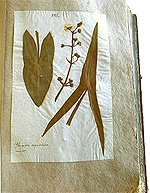Tennessee
Natural Heritage Program
Rare Plant
List
2012
Morefield's
Leather-flower
Clematis
morefieldii Kral
State
Status: Endangered
Federal
Status: Endangered
Division of Natural Areas, Tennessee Department of Environment and
Conservation
Tennessee
Department of Environment and Conservation
Division of
Natural Areas
401 Church
Street, 7th Floor L&C Tower
Nashville,
Tennessee 37243-0447
phone
615/532-0431 fax 615/532-3019
http://www.tn.gov/environment/na
The
development of this list has depended on the experience, expertise and
dedication of the members of the Rare Plant Scientific Advisory Committee. Past
State Botanists Claude Bailey, Carl Nordman, Milo Pyne and Dr. Paul Somers have
also made exceptional contributions to this effort. The information used in
compiling this list is the result of efforts by current and previous Tennessee
Natural Heritage Program staff over the past 38 years.
INTRODUCTION
The
mission of the Tennessee Division of Natural Areas (DNA) is to protect the
state’s plants, animals, and natural communities that
represent
the natural biological diversity of Tennessee. The DNA conducts a variety of
programs and activities for accomplishing the
conservation,
restoration, and management of Tennessee’s vast diversity of natural resources.
One of the division’s
greatest values is the
provision
of technical assistance to public and private land managers. This assistance
helps ensure that management decisions are made
with
knowledge of the significance and value of the natural resource. DNA carries
out its mission through the Natural Heritage Inventory
Program,
Natural Areas Program, Ginseng Program, and the Scenic Rivers Program.
The
DNA began in 1974, with the assistance of The Nature Conservancy (TNC), and was
known then as the Tennessee Natural Heritage
Program.
The purpose of the program was to provide science-based information on
biodiversity to aid in selection of sites considered for
the
state’s natural areas system. The number of rare species records grew and the
scope of the program expanded to include
environmental
review processes.
The
DNA relies on geographic information systems (GIS) databases to record and
report important information regarding the state’s rare
plants,
animals, and natural communities. The primary database (Biotics) was developed
by NatureServe, the non-governmental parent
organization
of natural heritage programs. DNA staff direct and conduct field surveys for
rare species and significant natural areas, as well
as
provide technical assistance regarding the distribution, conservation and
management of Tennessee’s biological diversity.
Information
from the Biotics database helps accomplish the goals of conservation and
protection of biological diversity. Federal, state, and
private
agencies, organizations, and individuals use rare species lists produced by the
DNA for environmental review and land management
decisions.
Currently 571 rare plant species are tracked by the state, including 225 listed
as state-endangered. DNA encourages
individuals
and organizations to assist staff biologists in determining accurate plant list
contents and ranking information.
Since
the late 1800s, field botanists have been gathering valuable information about
rare plants in Tennessee. Researchers have
continued
this important service up to the present day and the support of the scientific
community is a key part of the process of monitoring
rare
plants in Tennessee. Without this support, the quality and completeness of the
end product would be greatly diminished.
Plants
listed at the federal level are protected by the Endangered Species Act (ESA)
of 1973, as amended. The Fish and Wildlife Service
(FWS)
of the U.S. Department of the Interior administers the ESA and assigns federal
status designations to species that are threatened
with
extinction. Twenty-one plant species in Tennessee are listed under the ESA.
Plants
listed in Tennessee are protected by the Rare Plant Protection and Conservation
Act of 1985. The state-status of a rare plant is
determined
by the Tennessee Rare Plant Scientific Advisory Committee, consisting of twelve
botanists who are knowledgeable of the
state’s
flora. The committee is required to meet at least once every three years in
order to review and modify the list as needed. The
criteria
for listing a rare plant as endangered, threatened, or special concern, include
but are not limited to the following:
o
Distribution of the species in Tennessee and throughout its range.
o
Number of populations in Tennessee and throughout the species’ range.
o
Size of populations relative to estimates of minimal viable populations for the
species.
o
Habitat specificity.
o
Known or perceived threats to the species and its habitats.
o
Number of protected populations.
o
Difficulty of adequately protecting or managing habitats for the species’
survival.
o
Biological factors including the species’ ability to reproduce, respond to
disturbance, or its dependence on other species that may
also
be in jeopardy.
Any
interested person may nominate a plant species for listing or recommend changes
in status or removal of species from the current rare
plant
list promulgated under the act. Copies of The Rare Plant Protection and
Conservation Act of 1985 (TCA §§70-8-301 – 314) and the
associated
rules (Chap. 0400-6-2) are available upon request.
(Adapted
from Rules of Tennessee Division of Ecological Services, Chap 0400-6-2, Rare
Plant Protection and Conservation
Regulations.)





